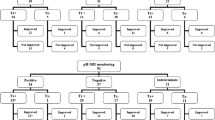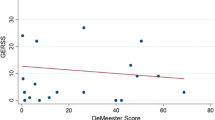Abstract
Introduction
A small cohort of patients present after antireflux surgery complaining of recurrent heartburn. Over two thirds of these patients will have a negative 24-h pH study. The aim of our study is to determine whether these patients have an associated functional disorder or abnormal cytokine activity and to examine the reproducibility of pH testing.
Methods
A prospective analysis was carried out on a cohort of patients who had undergone a fundoplication and postoperative pH testing for recurrent heartburn: group A—patients with recurrent heartburn and a negative 24-h pH study and group B (control group)—patients with recurrent heartburn and a positive pH study. Questionnaires, a blood sample, and repeat pH testing were completed.
Results
Sixty-nine patients were identified. Group A’s depression score (8.6 ± 4.1) was significantly higher than group B’s (5.9 ± 4.2; P = 0.03). Cytokine levels were similar in both groups. Forty-seven of 49 (96%) patients who underwent repeat pH testing had a negative study. Symptom-reflux correlation was highly significant (P < 0.001).
Conclusion
Some patients with recurrent heartburn and a negative pH study have associated functional or psychiatric comorbidities such as depression. Reproducibility of 24-h pH testing in these patients is excellent.
Similar content being viewed by others
References
Salminen PT, Hiekkanen HI, Rantala AP, Ovaska JT. Comparison of long-term outcome of laparoscopic and conventional Nissen fundoplication: a prospective randomized study with an 11-year follow-up. Ann Surg 2007;246:201–206. doi:10.1097/01.sla.0000263508.53334.af.
Morgenthal CB, Shane MD, Stival A, Gletsu N, Milam G, Swafford V, et al. The durability of laparoscopic Nissen fundoplication: 11-year outcomes. J Gastrointest Surg 2007;11:693–700. doi:10.1007/s11605-007-0161-8.
Sgromo B, Irvine LA, Cuschieri A, Shimi SM. Long-term comparative outcome between laparoscopic total Nissen and Toupet fundoplication: symptomatic relief, patient satisfaction and quality of life. Surg Endosc 2008;22:1048–1053. doi:10.1007/s00464-007-9671-4.
Zaninotto G, Portale G, Costantini M, Rizzetto C, Guirroli E, Ceolin M, et al. Long-term results (6–10 years) of laparoscopic fundoplication. J Gastrointest Surg 2007;11:1138–1145. doi:10.1007/s11605-007-0195-y.
Spechler SJ, Lee E, Ahnen D, Goyal RK, Hirano I, Ramirez F, et al. Long-term outcome of medical and surgical therapies for gastroesophageal reflux disease: follow-up of a randomized controlled trial. JAMA 2001;285:2331–2338. doi:10.1001/jama.285.18.2331.
Arguedas MR, Heudebert GR, Klapow JC, Centor RM, Eloubeidi MA, Wilcox CM, VA Cooperative Study Group, et al. Re-examination of the cost-effectiveness of surgical versus medical therapy in patients with gastroesophageal reflux disease: the value of long-term data collection. Am J Gastroenterol 2004;99:1023–1028. doi:10.1111/j.1572-0241.2004.30891.x.
Thompson SK, Jamieson GG, Myers JC, Chin KF, Watson DI, Devitt PG. Recurrent heartburn after laparoscopic fundoplication is not always recurrent reflux. J Gastrointest Surg 2007;11:642–647. doi:10.1007/s11605-007-0163-6.
Galvani C, Fisichella PM, Gorodner MV, Perretta S, Patti MG. Symptoms are a poor indicator of reflux status after fundoplication for gastroesophageal reflux disease: role of esophageal functions tests. Arch Surg 2003;138:514–518. doi:10.1001/archsurg.138.5.514.
Lord RV, Kaminski A, Oberg S, Bowrey DJ, Hagen JA, DeMeester SR, et al. Absence of gastroesophageal reflux disease in a majority of patients taking acid suppression medications after Nissen fundoplication. J Gastrointest Surg 2002;6:3–9. doi:10.1016/S1091-255X(01)00031-2.
Khajanchee YS, O’Rourke RW, Lockhart B, Patterson EJ, Hansen PD, Swanstrom LL. Postoperative symptoms and failure after antireflux surgery. Arch Surg 2002;137:1008–1013. doi:10.1001/archsurg.137.9.1008.
Adam B, Liebregts T, Holtmann G. Mechanisms of disease: genetics of functional gastrointestinal disorders—searching the genes that matter. Nat Clin Pract Gastroenterol Hepatol 2007;4:102–10. doi:10.1038/ncpgasthep0717.
Liebregts T, Adam B, Bredack C, Roth A, Heinzel S, Lester S, et al. Immune activation in patients with irritable bowel syndrome. Gastroenterology 2007;132:913–920. doi:10.1053/j.gastro.2007.01.046.
Zigmond AS, Snaith RP. The hospital anxiety and depression scale. Acta Psychiatr Scand 1983;67:361–370. doi:10.1111/j.1600-0447.1983.tb09716.x.
Talley NJ, Haque M, Wyeth JW, Stace NH, Tytgat GN, Stanghellini V, et al. Development of a new dyspepsia impact scale: the Nepean Dyspepsia Index. Aliment Pharmacol Ther 1999;13:225–235. doi:10.1046/j.1365-2036.1999.00445.x.
Pehl C, Boccali I, Hennig M, Schepp W. pH probe positioning for 24-hour pH-metry by manometry or pH step-up. Eur J Gastroenterol Hepatol 2004;16:375–382. doi:10.1097/00042737-200404000-00002.
Can MR, Yagci G, Cetiner S, Gulsen M, Yigit T, Ozturk E, et al. Accurate positioning of the 24-hour pH monitoring catheter: agreement between manometry and pH step-up method in two patient positions. World J Gastroenterol 2007;13:6197–6202. doi:10.3748/wjg.13.6197.
Johnsson F, Joelsson B. Reproducibility of ambulatory oesophageal pH monitoring. Gut 1988;29:886–889. doi:10.1136/gut.29.7.886.
Franzen T, Grahn LT. Reliability of 24-hour oesophageal pH monitoring under standardized conditions. Scand J Gastroenterol 2002;37:6–8. doi:10.1080/003655202753387275.
Wiener GJ, Morgan TM, Copper JB, Wu WC, Castell DO, Sinclair JW, et al. Ambulatory 24-hour esophageal pH monitoring—reproducibility and variability of pH parameters. Dig Dis Sci 1988;33:1127–1133. doi:10.1007/BF01535789.
Shay S, Richter J. Direct comparison of impedance, manometry, and pH probe in detecting reflux before and after a meal. Dig Dis Sci 2005;50:1584–1590. doi:10.1007/s10620-005-2901-5.
Zerbib F, Duriez A, Roman S, Capdepont M, Mion F. Determinants of gastro-oesophageal reflux perception in patients with persistent symptoms despite proton pump inhibitors. Gut 2008;57:156–160. doi:10.1136/gut.2007.133470.
Bredenoord AJ, Draaisma WA, Weusten BLAM, Gooszen HG, Smout AJPM. Mechanisms of acid, weakly acidic and gas reflux after anti-reflux surgery. Gut 2008;57:161–166. doi:10.1136/gut.2007.133298.
Roman S, Poncet G, Serraj I, Zerbib F, Boulez J, Mion F. Characterization of reflux events after fundoplication using combined impedance-pH recording. Br J Surg 2007;94:48–52. doi:10.1002/bjs.5532.
Smout AJPM. Endoscopy-negative acid reflux disease. Aliment Pharmacol Ther 1997;11(Suppl 2):81–85. doi:10.1046/j.1365-2036.1997.116287000.x.
Keohane J, Quigley EM. Functional dyspepsia and nonerosive reflux disease: clinical interactions and their implications. MedGenMed 2007;9:31.
Holtmann G, Liebregts T, Siffert W. Molecular basis of functional gastrointestinal disorders. Best Pract Res Clin Gastroenterol 2004;18:633–640. doi:10.1016/j.bpg.2004.04.006.
Watson DI, Chan ASL, Myers JC, Jamieson GG. Illness behaviour influences the outcome of laparoscopic antireflux surgery. J Am Coll Surg 1997;184:44–48.
Hayden JD, Myers JC, Jamieson GG. Analysis of illness behavior in patients after “failed” antireflux surgery. Arch Surg 2006;141:243–246. doi:10.1001/archsurg.141.3.243.
Tew S, Jamieson GG, Pilowsky I, Myers J. The illness behavior of patients with gastroesophageal reflux disease with and without endoscopic esophagitis. Dis Esophagus 1997;10:9–15.
Boyce PM, Talley NJ, Burke C, Koloski NA. Epidemiology of the functional gastrointestinal disorders diagnosed according to Rome II criteria: an Australian population-based study. Int Med J 2006;36:28–36. doi:10.1111/j.1445-5994.2006.01006.x.
Gwee KA, Chua ASB. Functional dyspepsia and irritable bowel syndrome, are they different entities and does it matter? World J Gastroenterol 2006;12:2708–2712.
De Vries DR, Van Herwaarden MA, Baron A, Smout AJ, Samsom M. Concomitant functional dyspepsia and irritable bowel syndrome decrease health-related quality of life in gastroesophageal reflux disease. Scand J Gastroenterol 2007;42:951–956. doi:10.1080/00365520701204204.
Budavari AI, Olden KW. Psychosocial aspects of functional gastrointestinal disorders. Gastroenterol Clin North Am 2003;32:477–506. doi:10.1016/S0889-8553(03)00030-X.
Velanovich V. The effect of chronic pain syndromes and psychoemotional disorders on symptomatic and quality-of-life outcomes of antireflux surgery. J Gastrointest Surg 2003;7:53–58. doi:10.1016/S1091-255X(02)00136-1.
Melzer J, Rosch W, Reichling J, et al. Meta-analysis: phytotherapy of functional dyspepsia with the herbal drug preparation STW 5 (Iberogast). Aliment Pharmacol Ther 2004;20:1279–1287. doi:10.1111/j.1365-2036.2004.02275.x.
Pilichiewicz AN, Horowitz M, Russo A, Maddox AF, Jones KL, Shemann M, et al. Effects of Iberogast on proximal gastric volume, antropyloroduodenal motility and gastric emptying in healthy men. Am J Gastroenterol 2007;102:1276–1283. doi:10.1111/j.1572-0241.2007.01142.x.
Bonatti H, Bammer T, Achem SR, Lukens F, DeVault KR, Klaus A, et al. Use of acid suppressive medications after laparoscopic antireflux surgery: prevalence and clinical indications. Dig Dis Sci 2007;52:267–272. doi:10.1007/s10620-006-9379-7.
Kamolz T, Granderath FA, Bammer T, Pasiut M, Pointner R. Psychological intervention influences the outcome of laparoscopic antireflux surgery in patients with stress-related symptoms of gastroesophageal reflux disease. Scand J Gastroenterol 2001;36:800–805.
Haag S, Senf W, Tagay S, Langkafel M, Braun-Lang U, Pietsch A, et al. Is there a benefit from intensified medical and psychological interventions in patients with functional dyspepsia not responding to conventional therapy? Aliment Pharmacol Ther 2007;25:973–986.
Acknowledgments
We would like to thank Carolyn Lally for all her help in managing the Royal Adelaide Hospital fundoplication database and Janet Pinno, Lorelle Smith, and Nicky Ascott for their hard work in completing the postoperative follow-up for all patients in the database. We would also like to acknowledge the diligent work of Tobias Liebregts and Birgit Adam in analyzing the blood samples.
Author information
Authors and Affiliations
Corresponding author
Rights and permissions
About this article
Cite this article
Thompson, S.K., Cai, W., Jamieson, G.G. et al. Recurrent Symptoms after Fundoplication with a Negative pH Study—Recurrent Reflux or Functional Heartburn?. J Gastrointest Surg 13, 54–60 (2009). https://doi.org/10.1007/s11605-008-0653-1
Received:
Accepted:
Published:
Issue Date:
DOI: https://doi.org/10.1007/s11605-008-0653-1




